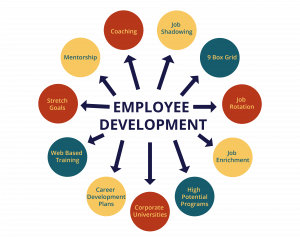13.4 Employee Development: Part Two – Employee Personal Development
Employee personal development helps with employee motivation and retention. There are few things more motivating for employees than knowing that the company that they work for is committed to their professional development. Conversely, an employer who does not focus on employee learning is going to suffer from low performance, engagement and retention. According to LinkedIn’s 2018 Workforce Learning Report, a whopping 93% of employees say that they would stay at a company longer if it invested in their careers. People want to know how their goals and aspirations fit with the plans of the company that they work for.
Employee Development Guidelines
A successful employee development program involves buy-in and a connection to the organization’s overall goals. Let’s look at a few guidelines that help support this initiative:
- Buy-In: Holding meetings ahead of time to get upper-management buy-in can speed up the process. Answering their questions, providing clarity and communicating how your succession planning program supports the business is critical to your success.
- Involvement: Have the upper-management team involved in the program roll-out. Asking them to communicate the highlights of the program will emphasize the value they see in their employees.
- Connection: Ensure your employee development program is related to your performance management program. Employees want to know what to expect and how these programs relate to one another.
- Values: How do your employees see employee development and what value do they put on such programs? Employees are often very interested in their development and appreciate when an organization invests time and money in these initiatives.
- Outcome: Has your organization communicated the skills, abilities and knowledge each employee will achieve as a result of the employee development program? It is important to focus on the skills your organization will need most going forward.
Employee Development Methods
Let’s review methods of enhancing an employee’s skills, ability and knowledge for future job assignments.

9-Box Grid
When assessing an employee’s current contribution to your organization as well as their potential contribution, the 9-box grid is an effective tool. This visual tool allows people leaders to see an employee’s likelihood of filling a leadership role in the future. A manager can include both performance appraisal information and the results of employee assessments in the grid. To learn more about the use of a 9-box gride, please visit the following site: Using The 9-Box Grid With The Performance Values Matrix (workdove.com)
“Stretch” Goals
Providing employees with opportunities to work on projects or assignments that require skills typically associated with next-level positions will stretch an individual and allow them to attain new competencies they will need for future job postings.
Job Rotation
Allowing employees to move between jobs in the organization is known as job rotation. Regardless of the size of your company, you can identify roles that can be shared by many individuals. Job rotation allows an employee to gain skills and abilities in a variety of roles that will assist with their promotability.
Job Enrichment
Adding a higher level of responsibility and control to an existing employee’s job description can be motivating. Explaining to an individual that part of their growth at this organization involves taking on a greater degree of responsibility for people or a process demonstrates that the organization believes they are ready for the challenge.
Corporate Universities
Some industry leading organizations put a lot of effort into employee development and even invest in what is classified as ‘corporate universities’. These in-house learning institutions are modeled after universities with programs, courses, and credits. CGI, for example, at the CGI Leadership Institute which offers courses such as CGI 101 and CGI 201 as well as courses on leadership and project management. Another famous example is McDonald’s Hamburger University which was founded in 1961 and has more than 275,000 graduates.
High Potential Programs
High potential (hi-po) programs are concerned with the early identification and the development of employees who have the potential to assume leadership positions in the future. If we would transpose such a program in the hockey world, it would be a system that identifies pee-wee players with the most potential and make sure that they get the coaching and the team environment needed to develop into elite NHL players. Keys to these programs are (a) the identification of talent and (b) the development of this talent. First, potential has to be identified early. Large organizations often flag hi-po’s in their very first years in the company. This early identification is difficult to do and often leads to false positives (or employees identified as hi-po’s who do not develop into superior executives). This is the reason why companies tend to cast a wide net and identify as many hi-po’s as possible. After talent has been identified, it needs to be groomed. Over time, the careers of hi-po’s are carefully managed to make sure that they reach their full potential. For example, HR managers often use developmental experiences such as international assignments to make sure that hi-po’s are put in situations where they can grow.
Career Development Plans
A career development plan usually includes a list of short- and long-term goals that employees have about their current and future jobs, and a planned sequence of formal and informal training and experiences needed to help them reach their goals. As this chapter has discussed, the organization can and should be instrumental in defining what types of training. Both in-house and external that can be used to help develop employees.
Sample Career Development Plan Developed by an Employee and Commented on by Her Manager
| Today’s Date | February 15, 2020 |
|---|---|
| Employee | Sammie Smith |
| Current Job Title | Clerk, Accounts Payable |
| Goals |
|
| Estimated Costs |
|
| Completion Date | Spring of 2020 |
Manager Notes:
The budget allows us to pay up to $1,000 per year for external training for all employees. Talk with Sammie about how to receive reimbursement. |
|
As you can see, the employee developed goals and made suggestions on the types of training that could help Sammie meet their goals. Based on this data, the manager suggested in-house training and external training to reach their goals within the organization.
Operations Manager Toolkit
“Employee Development” in Human Resources Management – 2nd Ontario Edition by Elizabeth Cameron is licensed under a Creative Commons Attribution-NonCommercial-ShareAlike 4.0 International License, except where otherwise noted.


